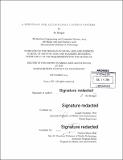A substrate for accountable layered systems
Author(s)
Morgan, Bo
DownloadFull printable version (16.67Mb)
Other Contributors
Massachusetts Institute of Technology. Department of Architecture. Program in Media Arts and Sciences.
Advisor
Joseph Paradiso.
Terms of use
Metadata
Show full item recordAbstract
A system built on a layered reflective cognitive architecture presents many novel and difficult software engineering problems. Some of these problems can be ameliorated by erecting the system on a substrate that implicitly supports tracing the behavior of the system to the data and through the procedures that produced that behavior. Good traces make the system accountable; it enables the analysis of success and failure, and thus enhances the ability to learn from mistakes. This constructed substrate provides for general parallelism and concurrency, while supporting the automatic collection of audit trails for all processes, including the processes that analyze audit trails. My system natively supports a Lisp-like language. In such a language, as in machine language, a program is data that can be easily manipulated by a program, making it easier for a user or an automatic procedure to read, edit, and write programs as they are debugged. Constructed within this substrate is an implementation of the bottom four layers of an Emotion Machine cognitive architecture, including built-in reactive, learned reactive, deliberative, and reflective layers. A simple natural language planning language is presented for the deliberative control of a problem domain. Also, a number of deliberative planning algorithms are implemented in this natural planning language, allowing a recursive application of reflectively planned control. This recursion is demonstrated in a fifth super-reflective layer of planned control of the reflective planning layer, implying N reflective layers of planned control. Here, I build and demonstrate an example of reflective problem solving through the use of English plans in a block building problem domain. In my demonstration an AI model can learn from experience of success or failure. The Al not only learns about physical activities but also reflectively learns about thinking activities, refining and learning the utility of built-in knowledge. Procedurally traced memory can be used to assign credit to those thinking processes that are responsible for the failure, facilitating learning how to better plan for these types of problems in the future.
Description
Thesis: Ph. D., Massachusetts Institute of Technology, School of Architecture and Planning, Program in Media Arts and Sciences, 2013. Cataloged from PDF version of thesis. Includes bibliographical references (pages 193-196).
Date issued
2013Department
Program in Media Arts and Sciences (Massachusetts Institute of Technology)Publisher
Massachusetts Institute of Technology
Keywords
Architecture. Program in Media Arts and Sciences.